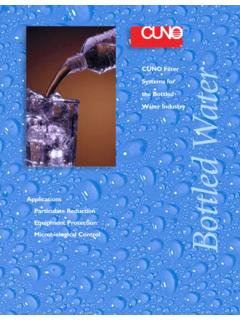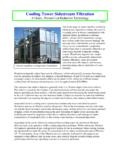Transcription of Sand Filter - Houston-Galveston Area Council
1 sand filterTwo-compartment septic tank with pumping chamberDischarge to soilabsorption fieldOn-site wastewater treatment systemsSand filterBruce LesikarExtension Agricultural Engineering SpecialistThe Texas A&M University SystemL-52292-99 Figure 1: A sand Filter filtration is one of the oldest wastewater treatment technolo-gies known. If properly designed, constructed, operated andmaintained, a sand Filter produces a very high quality filters are beds of granular material, or sand , drained fromunderneath so that pretreated wastewater can be treated, collected anddistributed to the land application system.
2 They are normally usedto polish effluent from septic tanks orother treatment processes before it isdistributed on the land. All on-sitesystems are no-discharge, meaningthe wastewater must stay in thesystem and not leave the typical sand Filter is a linedwatertight box, generally concrete- orplastic-lined, and filled with a specificsand material. Types of sand filtersinclude:3 Intermittent sand Filter , in whichwastewater is applied periodicallyto a 24- to 36-inch-deep bed ofsand that is underdrained to collectand discharge the effluent.
3 Thebed is underlain by graded graveland collecting tile. Wastewater isapplied intermittently to the bed ssurface through distribution wastewater cannot enter surfacewater, streams, ditches or any waterresources. After the filtrate is collectedby the sand Filter s under drains, it isthen disposed of by a soil appliedto the sand filtershould be pretreated,such as in aseptic tank3 Recirculating intermittent sandfilter, which filters wastewater bymixing filtrate with incomingseptic tank effluent and recircu-lating it several times through thefilter media before discharging itto a final land application Filter s components aresimilar to the intermittent sandfilter filters can be free access(open to the surface)
4 Or buried in theground (buried filters). Free accesssand filters are generally aboveground and usually have a lid thateases access to the sand design helps the systemblend into its surroundings. A buriedsand Filter is completely covered andeasily blends into the sand Filter purifies the water inthree ways:3 Filtration, in which particles arephysically strained from theincoming wastewater;3 Chemical sorption, in whichcontaminants stick to the surfaceof the sand and to the biologicalgrowth on the sand surface; and3 Assimilation, in which aerobicmicrobes eat the nutrients in thewastewater.
5 The success oftreating wastewater depends onthese microbes. Air must beavailable for these microbes filters are often partially orcompletely buried in the ground, butmay be built above ground wherethere is a high water table or in areas with much rainand long periods of subfreezingtemperatures, the sand Filter shouldhave some form of applied to the sandfilter should be pretreated, such as ina septic tank. The effluent from theseptic tank is then distributed uni-formly on the sand distribute the wastewater, adosing siphon can be used with splashplates.
6 Another approach is to pumpthe effluent under low-pressure,controlled doses through a network ofsmall-diameter pipes. The pipes areplaced in a bed filled with gravel ontop of the sand . The effluent leavesthe pipes, trickles down through thegravel and is treated as it filtersthrough the gravel under-drain collects andmoves the treated wastewater to eithera second pump chamber for dischargeto a pressurized distribution system orto a gravity flow soil absorption second pump chamber may belocated in the sand typical sand Filter is aconcrete- or PVC-lined box filledwith a specific sand material.
7 Themedia depth ranges from 24 to s important that the sandparticles all be about the same size. Ifthe grain sizes vary greatly, thesmaller ones will fill in the spacesbetween the larger particles, making iteasier for the system to larger the grain size, thefaster the wastewater moves throughthe sand and the more wastewater thatcan be filtered. Small media slow thewater movement and increase thechance of clogging. The grain sizealso affects how deep the solidparticles penetrate the Filter and howclean the final effluent 2: A sand s important that thesand particles all beabout the same sizeDifferent types of sand filters canhandle different amounts of wastewa-ter.
8 Buried sand filters generally canhandle gallons of wastewater persquare foot of sand Filter surface areaper day (gpsfd). This low loadingcapacity results from the system slimited maintenance needs. Using aburied sand Filter , a three-bedroomhome with a flow of 240 gallons perday would require 200 square feet ofsand Filter (about 14 feet by 14 feet).An intermittent recirculating freeaccess sand Filter can have loadingrates up to 15 gpsfd. To reduce thesize of the sand Filter , the designermay use a free access sand Filter witha higher loading rate, but the higherrate generally means more mainte-nance requirements.
9 For this system, athree-bedroom home (240 gallons aday) with a sand Filter loading rate of10 gpsfd would have a 24-square-footsand Filter (6 feet by 4 feet).How to keep it workingSeveral factors affect the Filter sperformance, including two importantenvironmental conditions: aerationand temperature. Oxygen needs to beavailable within the pores so thatmicrobes can break down the solids inthe wastewater. If the Filter has poorair movement, such as when it iscovered with heavy clay, the systemcan directly affects therate of microbial growth, chemicalreactions, adsorption mechanisms andother factors that contribute to thestabilization of wastewater.
10 Lowertemperatures usually slow the rate ofmaterial requirements forsand filters depend on the type offilter. Buried sand filters are designedto limit the need for maintenance. Themost important maintenance for themElectrical conduitFilter fabricLoamy sandPVC hose and valve assemblyPVC pipe to land applicationLinerPump basinFloat assemblyCheck valveSubmersible pump3/8 inch pea gravelFilter sandSand18 inches2 inch sand leveling layeris to make sure the pretreatmentsystem is working properly. Applyingsolids, grease or scum to the surfaceof a buried Filter greatly reduces itslife.








